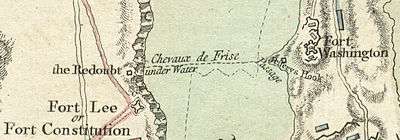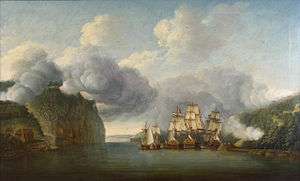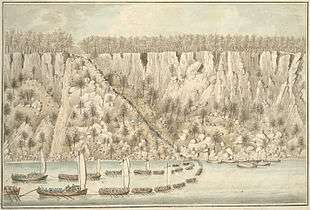Fort Lee Historic Park
Fort Lee Historic Park is located atop a bluff of the Hudson Palisades overlooking Burdett's Landing, known as Mount Constitution,[1] in Fort Lee, New Jersey. Native Americans appear to have lived in the area for thousands of years before the arrival of Europeans.[2] Site of George Washington's 1776 encampment opposite Fort Washington at the northern end of Manhattan.[3] Fort Lee is named for General Charles Lee. The site is a reconstruction of the encampment including the blockhouse, battery, quarters as well as a visitors center. It is part of Palisades Interstate Park.
| Fort Lee Historic Park | |
|---|---|
 | |
| Location | Fort Lee, New Jersey |
| Coordinates | 40°51′01″N 73°57′47″W |
| Area | 33 acres |
At the north end of the park there are two overlooks with views of the George Washington Bridge, the Hudson River, and the skyline of upper Manhattan. There is metered parking.
Fort Lee (American Revolutionary War)

Fort Lee, originally Fort Constitution, was an American Revolutionary War fort located on the crest of the Hudson Palisades in what was then Hackensack Township, New Jersey opposite Fort Washington at the northern end of Manhattan Island.
Construction
General George Washington issued orders to General Mercer to summon all available troops and erect a fort on the west side of the Hudson River. Construction commenced in July 1776 [4] on the new fort, to be called Fort Constitution.[1] It was located on the western side of the road that led up the hill from the landing. Concurrently, Fort Washington was being built almost directly across the North River (Hudson River) in New York.[5] Chevaux-de-frise, south of the Hudson River Chain, were laid between them.[6]
Defense of the Hudson River

These twin forts were intended to protect the lower Hudson from British warships. At first, efforts were concentrated close to the water level near Burdett's Landing.[5] Later, fortifications were added atop the bluff under the supervision of Joseph Philips, Battalion Commander of the New Jersey State Militia.[1] The Bourdette's ferry service was taken over by the Army,[7] and Peter Bourdette was forced to vacate his house; although as a patriot he considered it no sacrifice and offered the work of his slaves to General Mercer's construction efforts.[5] At the end of September 1776, Fort Constitution was renamed Fort Lee, for General Charles Lee of the Continental Army.[1] George Washington used the stone Bourdette house for his headquarters when he passed time at Fort Lee.[1] At this stage of the war the ferry operated as a supply line and the only link between Forts Lee and Washington.[5][8]
Battle of Fort Lee
The Battle of Fort Lee on November 20, 1776 marked the successful invasion of New Jersey by British and Hessian forces and the subsequent general retreat of the Continental Army during the American Revolutionary War.
Background
Peter Bourdette's sixteen-year-old son, also named Peter, provided assistance by direct use of the landing. During the week leading up to the evacuation of Fort Lee[5] he rowed back and forth across the river gathering information for General Washington on the anticipated movements of the British forces.[9] Well after dark on the night before the battle for New York at Fort Washington, George Washington was rowed from Burdett's Landing to the middle of the Hudson River for a strategy session with his senior officers in charge of New York, who rowed to meet him.[7][10] On November 16, 1776, George Washington witnessed the battle for New York from across the river on the bluff of Fort Lee, above Burdett's Landing.[11]
British invasion
Fort Lee was rendered defenseless after Continental Army troops holding Fort Washington were defeated and captured on November 16, 1776. The Royal Navy controlled the Hudson River. General William Howe ordered Charles Cornwallis to "clear the rebel troops from New Jersey without a major engagement, and to do it quickly before the weather changed."[12] The force included Hessian units commanded by Colonel Carl von Donop.[13] The invasion of New Jersey began the night of November 19–20, when 5,000 British troops ferried across the Hudson on barges and began landing near New Dock Landing (present-day Alpine). George Washington and Nathanael Greene quickly ordered the evacuation of the fort on the morning of November 20, 1776.[14]
American retreat
The soldiers then began a hasty retreat west, crossing the Hackensack River at New Bridge Landing and the Passaic River at Acquackanonk Bridge[15][16][17][18][19] It was during Washington's retreat (beginning along a road which is now Main Street)[20][21] that Thomas Paine composed his pamphlet, "The American Crisis", which began with the recognized phrase, "These are the times that try men's souls".[22]
Fort Lee Museum and Monument Park
Fort Lee Museum is located in Monument Park. which was created by the Daughters of the American Revolution and dedicated in 1908 at ceremony attended by General John "Black Jack" Pershing. The park was part of the original Fort Constitution of the Continental Army under the leadership of General George Washington. Over 2,600 troops were stationed in and around the Monument Park area. In 2004, the park was reconstructed for the Fort Lee Centennial Celebration. A time capsule was placed at the foot of the monument, to be opened at the Bicentennial Celebration in the year 2104. Monument Park and Continental Army Plaza in Williamsburg, Brooklyn are the only parks in the United States dedicated to the soldiers of the American Revolution.[23]
 Hiking Path
Hiking Path View of Manhattan
View of Manhattan Historic Cannon
Historic Cannon Fort Lee Historic Park, Ross Dock Picnic Area
Fort Lee Historic Park, Ross Dock Picnic Area
See also
References
- "Revolution: Pre-Revolution". Archived from the original on March 1, 2009. Retrieved March 11, 2009.
- Winson, Terrie (March 2002). "Lenni Lenape". Retrieved March 12, 2009.
- Adams (1996), p. 106.
- "Wars and Battles, November 20, 1776". Retrieved March 15, 2009.
- Hoy, Carla. "History and Profile, Fort Lee Historical Highlights". Retrieved March 10, 2009.
- Diamant, Lincoln (2004). Chaining the Hudson: The Fight for the River in the American Revolution. Fordham University Press. p. 44. ISBN 978-0-8232-2339-8.
- Renner, James (October 2003). "Burdett's Ferry". Archived from the original on December 13, 2007. Retrieved March 5, 2009.
- Adams (1996), pp. 103–4.
- Van Walen, James M. (1900). History of Bergen County, New Jersey. New Jersey Publishing and Engraving Co. p. 499.
- Cheslow, Jerry (July 30, 1995). "If You're Thinking of Living In: Edgewater; Factory Town Is Now Bedroom Community". New York Times. Retrieved March 16, 2009.
- Adams (1996), p. 105.
- Fischer (2004), p. 121.
- Lefkowitz (1998), p. 44.
- Spring (2007), p. 27.
- "Main Avenue Bridge". NYC Bridges. 2012. Retrieved May 26, 2015.
- "Masonry and Metal The Historic Bridges of Bergen County, New Jersey" (PDF). Richard Grubb and Associates. 2008. Archived from the original (PDF) on July 10, 2012. Retrieved August 21, 2012.
- "Archived copy". Archived from the original on December 19, 2015. Retrieved September 28, 2015.CS1 maint: archived copy as title (link)
- "Passaic, New Jersey Revolutionary War Sites – Passaic Historic Sites". revolutionarywarnewjersey.com. Retrieved September 28, 2015.
- "Full text of "Washington and his army at Acquackanonk : an incident of the retreat of 'seventy-six"". archive.org. Retrieved September 28, 2015.
- "Fort Lee Road Marker". hmdb.org. Retrieved November 20, 2015.
- The British Invasion & Washington's Retreat – Nov 20–21, 1776 jpg map of Bergen County.
- "Hackensack New Jersey (History)". rays-place.com. Retrieved November 20, 2015.
- "fort lee Monument Park". Archived from the original on December 3, 2008. Retrieved February 17, 2010.
- "Fort Lee Museum". Archived from the original on January 12, 2010. Retrieved February 17, 2010.
- "Thomas Paine Marker". hmdb.org. Retrieved November 20, 2015.
- "Fort Lee Monument Park". Archived from the original on December 3, 2008. Retrieved February 17, 2010.
Bibliography
- Adams, Arthur G. (1996). The Hudson River Guidebook. New York: Fordham University Press. ISBN 978-0-8232-1679-6.CS1 maint: ref=harv (link)
- Fischer, David Hackett (2004). "The Retreat. Cornwallis and the Conquest of New Jersey". Washington's Crossing. New York: Oxford University Press. ISBN 0-19-517034-2.CS1 maint: ref=harv (link)
- Hall, Edward Hagaman (1909). "Fort Lee, New Jersey. A Sketch of its Revolutionary History". Fourteenth Annual Report. New York: The American Scenic and Historic Preservation Society.CS1 maint: ref=harv (link)
- Lefkowitz, Arthur S. (1998). The Long Retreat: The Calamitous American Defense of New Jersey, 1776. New Brunswick, New Jersey: Rutgers University Press. ISBN 978-08135-2759-8.CS1 maint: ref=harv (link)
- Mack, Arthur C. (1909). "Historic Old Fort Lee". The Palisades of The Hudson. Edgewater, New Jersey: The Palisade Press. p. 13.CS1 maint: ref=harv (link)
- Spring, John (2007). "The Invasion and the Myths Surrounding It". In Karels, Carol (ed.). The Revolutionary War in Bergen County. South Carolina: History Press. ISBN 978-1-59629-358-8.CS1 maint: ref=harv (link)
External links
| Wikimedia Commons has media related to Fort Lee Historic Park. |
- Official website

- "Battle of Fort Lee and Retreat Across the Jerseys". Crossroads of the American Revolution.
- "Fort Lee Historic Park, NJ". Palisades Parks Conservancy.
- "Fort Lee Historic Park". Historical Marker Database.
- Route Description
